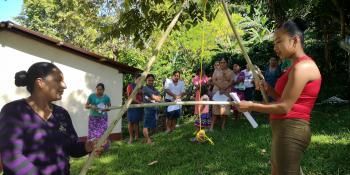Climate adaptation effort cuts hunger in African villages

Shift in farming techniques reduces number of households eating one or no meals each day in the Nyando basin, Kenya.
Feeding the projected 9 billion people in 2050 requires a radical transformation of agriculture. Since 2011, the CGIAR Research Program on Climate Change, Agriculture and Food Security (CCAFS) East Africa, together with partners such as International Livestock Research Institute (ILRI) and the International Potato Centre (CIP), development organizations and local government have been working with smallholder farmers in Africa towards a shift in farming techniques that include improved crop varieties and resilient livestock breeds. Initial results point to a reduction in the number of households eating one or no meals a day. Read more from this Nature news commentary published in the run up to the CSA Global Conference held in March 16 - 18.
An ambitious project to help smallholder farmers to adapt to climate change has significantly reduced hunger at test sites in East Africa. In seven villages in Kenya, for example, the number of households that experience at least two months per year with one or no meals per day fell by roughly 60 percentage points over a period of four years.
The African sites are part of an effort to turn villages on five continents into labs, testing new farming techniques, crop varieties and livestock breeds to improve food security in the face of climate change. Run by the CGIAR, a global partnership focused on agricultural research for food security, the project will present initial results from its 22 'climate-smart villages' at a conference in Montpellier, France, on 16–18 March.
Krystyna Swiderska, a researcher in agricultural and biodiversity at the International Institute for Environment and Development in London, says that climate change is already affecting farmers in developing countries, creating a clear need for better information and resources to help them to cope. “Those areas that are already finding it hard to produce food will be worst affected by climate change. More erratic rainfall and greater incidence of pests and disease is making it harder to grow food,” she says.
One of the longest-running test sites is a set of seven villages in the Nyando district of Kenya. There, the latest data show that the number of households eats just one or even no meals per day is falling. When 139 households in the area were surveyed in 2010-2011, 81% experienced up to two such 'hunger months' per year; that has since dropped to just 23%. And 3% of the households now have food year-round, compared to 1% in 2010-2011.
“The amount of food farmers are able to produce and consume is growing. The extra crops are filling that food deficit,” says James Kinyangi, who leads the CCAFS project in East Africa.
Farmers in the 22 test sites pick from a portfolio of approaches to help them to adapt to their individual environmental challenges, such as improved seeds or better access to fertilizer. The farmers also participate in research studies, such as testing whether growing legumes such as the pigeon pea (Cajanus cajan) in addition to staple crops such as maize (corn) can improve food security.
When the project began in Nyando, just 32% of households grew 'improved' crop varieties, and just a handful of farmers used inorganic fertilizer. Then CCAFS helped to make fertilizer and drought- and pest-resistant seeds accessible to the farmers through a nearby shop. By 2013, the average annual use of fertilizer had risen to 16 metric tonnes. And by 2014, around 92% of the 340 households surveyed were growing improved seed varieties.
Read the full story on Nature News Website.
Natasha Gilbert is a freelance journalist who writes for Nature and other scientific publications



